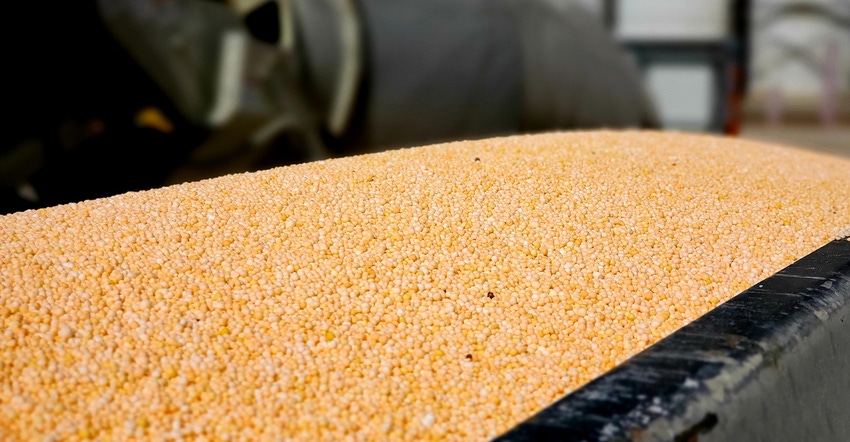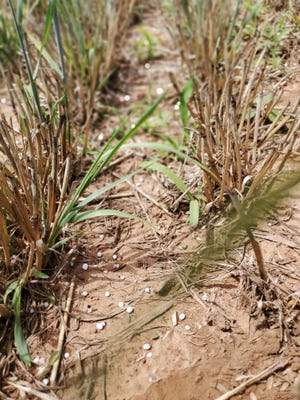
For numerous reasons, including weather, transportation delays, and trade issues, among others, farmers face significant price increases for many inputs essential to make yield goals.
In fact, availability and potential shortages of essential fertilizer products pose significant challenges for 2022 production.
Efficient fertilizer management will be essential, say nutrient research and Extension specialists from Texas and Oklahoma.
See, Herbicide availability, cost might affect control strategy
Texas AgriLife agronomists and soil scientist Wayne Keeling and Katie Lewis, respectively, offer a few thoughts on managing fertilizer applications.
“Rapidly rising fertilizer prices have complicated producers’ fertilizer management decisions,” says Keeling, Texas AgriLife professor, Soil and Crop Sciences, Lubbock.
 Before fertilizing, specialists recommend soil sampling first. (Photo by Shelley E. Huguley)
Before fertilizing, specialists recommend soil sampling first. (Photo by Shelley E. Huguley)
“First and foremost, soil sample,” says Lewis, associate professor, Soil Chemistry and Fertility, Texas A&M AgriLife Research, and Plant and Soil Science, Texas Tech University, Lubbock.
“Soil sampling/testing will be the primary means to reduce or possibly eliminate or postpone a fertilizer application,” she says. “For example, deeper sampling (to 36 or 48 inches) of nitrogen and sulfur can reveal substantial amounts of these essential plant nutrients that can be credited to your soil test.
“Irrigation water can also be used to credit both nitrogen and sulfur, but it first must be tested to determine what may be added with irrigation.”
Check phosphorus levels
“Phosphorus offers another example of the benefit of soil testing,” Keeling adds. “If testing shows medium or higher levels, postpone phosphorus applications until the next year when it’s possible that prices will be lower.”
Lewis says testing also may indicate that even when phosphorus needs to be added, producers may be able to reduce rates. “Total rates can be reduced by banding rather than applying broadcast. With the many fixation reactions that can occur with phosphorus in the soil, less than 30% is actually taken up by the plant within the year of application.
“However, uptake can be increased by applying in a band due to less exposure to soil compared to a broadcast application. Deeper placement, 6 to 10 inches, can also result in greater use efficiency.”
Less nitrogen?
“Nitrogen requirements of cotton have been determined to be less than previously believed with newer cultivars,” Lewis says. “Producers may reduce rates to 40 pounds per bale yield goal and save on input costs.
“Another potential saving with nitrogen can be achieved through proper timing and application method. It is always best to apply nitrogen below the surface (6 to 8 inches) in a band rather than surface applying. Proper timing and application method will always result in greater use efficiency.”
Lewis says producers with cover crops should consider the timing of additional nitrogen to the cash crop behind cover crops. “We have determined that the best use of added nitrogen to a cash crop following a cover crop is to apply a greater percentage of nitrogen fertilizer earlier in the season (preplant or shortly after emergence). Applying a larger percentage of nitrogen in-season (pinhead square) to a crop following a cover crop reduces use efficiency and ROI,” she says.
Keeling and Lewis offer three concluding thoughts to reduce fertilizer input costs:
“Soil test to determine what and how much is needed. Use optimum timing and method of application to increase use efficiency,” Lewis says. “Fertilize for reasonable yield goals and aim to maximize profit,” Keeling adds.
Brian Arnall, precision nutrient management specialist, Oklahoma State University, Stillwater, agrees that nitrogen testing should include deeper sampling. “Nitrogen soil testing will be of great value this coming season, but it needs to be moved beyond the 0- to 6-inch depth if we really want it to help,” Arnall says.
“There is a great deal of nitrogen throughout the soil profile, and while a soil test is only a snapshot in time, it is a great value if we determine whether we have 30 or 130 pounds of nitrogen in the top 2 feet of soil. I can promise many will be shocked by the amount of nitrogen they find at depth; same goes with sulfur.”
Wait on wheat, Less N on corn
Arnall says OSU has done a lot of work with wheat in the Central Plains and with corn in the Oklahoma Panhandle. “For the wheat we have found that the application of nitrogen can be significantly delayed, allowing for a better understanding of yield potential. We are also finding that we can grow a great bit of corn with a lot less nitrogen. Those deep High Plains soils have great capability to hold nitrogen.
 "Soil testing is one of the best ways to apply fertilizer efficiently,” OSU Small Grains Specialist Amanda De Oliveira Silva. (Photo by Shelley E. Huguley)
"Soil testing is one of the best ways to apply fertilizer efficiently,” OSU Small Grains Specialist Amanda De Oliveira Silva. (Photo by Shelley E. Huguley)
“In-season applications of nitrogen provide a great opportunity to adjust the nitrogen rate based upon more current information and making an application when conditions are suitable.”
Arnall says considering the situation facing producers in 2022, “using stabilizers/inhibitors will have more ROI than ever when utilized in environments with high loss potential.
See, 4 tips to stretch pest control dollars
“Also, this year specialty products will be pushed hard as replacements. But a pound of nitrogen is a pound of nitrogen; 1 will not equal 20.”
He adds that if producers use reference strips, High or No nitrogen needed will show the greatest ROI of any technique if utilized.
Use enough
OSU Small Grains Specialist Amanda De Oliveira Silva encourages wheat growers to use adequate nutrients, “mainly nitrogen and phosphorus for most regions in Oklahoma, to achieve maximum yield.
“Soil testing is one of the best ways to apply fertilizer efficiently,” De Oliveira Silva says. “Soil tests provide information about nutrient availability in the soil, potential needs, and may prevent us from over or under fertilizing the crop, which can help reduce fertilizer costs without losing yield.
“For grain-only systems, in season nitrogen application has demonstrated increases in both yield and protein when compared to pre-plant nitrogen applications. With in-season nitrogen application, producers have a better idea of the environmental conditions and yield potential of the crop. In addition, adding N-rich strips in wheat fields can help producers determine if in-season nitrogen is needed.”
Weather also plays a role, she says. “To determine if investing in inputs is worth the cost will depend on the risk producers are willing to take and how much they want to push yields (if the yield potential is there).
“When we talk about inputs in general, we need to keep in mind that wheat varieties differ on their responses to nitrogen and to fungicides. Knowing the disease resistance package of a specific variety and scouting for diseases will help save money with fungicide applications. Again, if a variety has the genetic resistance to the disease producers are trying to kill, there is no need to spray.”
Fertility always plays an important role in achieving crop yield goals, but with significant increases in prices looming for 2022, producers need to apply what the crop needs, when it needs it, and where it will do the most good.
Arnall refers producers and consultants to recent blog posts for more information.
About the Author(s)
You May Also Like






